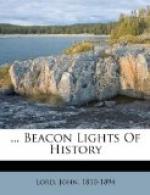Living in habits of intimacy with princes and cardinals,
he never addressed them in adulatory language, but
talked and acted like a nobleman of nature, whose
inborn and superior greatness could be tested only
by the ages. He placed art on the highest pinnacle
of the temple of humanity, but dedicated that temple
to the God of heaven in whom he believed. His
person was not commanding, but intelligence radiated
from his features, and his earnest nature commanded
respect. In childhood he was feeble, but temperance
made him strong. He believed that no bodily
decay was incompatible with intellectual improvement.
He continued his studies until he died, and felt
that he had mastered nothing. He was always dissatisfied
with his own productions. Excelsior was his motto,
as Alp on Alp arose upon his view. His studies
were diversified and vast. He wrote poetry as
well as carved stone, his sonnets especially holding
a high rank. He was engineer as well as architect,
and fortified Florence against her enemies.
When old he showed all the fire of youth, and his
eye, like that of Moses, never became dim, since his
strength and his beauty were of the soul,—ever
expanding, ever adoring. His temper was stern,
but affectionate. He had no mercy on a fool or
a dunce, and turned in disgust from those who loved
trifles and lies. He was guilty of no immoralities
like Raphael and Titian, being universally venerated
for his stern integrity and allegiance to duty,—as
one who believes that there really is a God to whom
he is personally responsible. He gave away his
riches, like Ambrose and Gregory, valuing money only
as a means of usefulness. Sickened with the
world, he still labored for the world, and died in
1564, over eighty-nine years of age, in the full assurance
of eternal blessedness in heaven.
His marbles may crumble down, in spite of all that
we can do to preserve them as models of hopeless imitation;
but the exalted ideas he sought to represent by them,
are imperishable and divine, and will be subjects
of contemplation when
“Seas shall waste, the
skies to smoke decay,
Rocks fall to dust,
and mountains melt away.”
AUTHORITIES.
Grimm’s Life of Michael Angelo; Vasari’s
Lives of the Most Excellent Painters, Sculptors and
Architects; Duppa’s Life of
Michael Angelo; Bayle’s Histoire de la Peinture
en Italie.
MARTIN LUTHER.
A. D. 1483-1546.
The protestant reformation.
Among great benefactors, Martin Luther is one of the
most illustrious. He headed the Protestant Reformation.
This movement is so completely inter-linked with
the literature, the religion, the education, the prosperity—yea,
even the political history—of Europe, that
it is the most important and interesting of all modern
historical changes. It is a subject of such amazing
magnitude that no one can claim to be well informed
who does not know its leading issues and developments,
as it spread from Germany to Switzerland, France,
Holland, Sweden, England, and Scotland.




